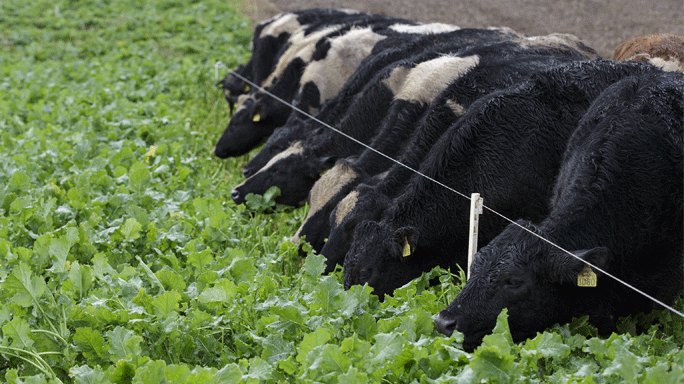Key points to keep in mind when grazing brassicas

Those that have brassicas in the ground this winter, grazing is under way. This year, with feed prices rising sharply, wintering stock outside is a particularly attractive option. Forage crops can help limit the reliance on bought-in feed, reduce labour, machinery and housing costs and reduce the need for winter conserved forage.
Introducing Brassica Forage Crops
Brassica forage crops can cause animal health disorders, grazing needs to be controlled and animals need to be watched closely during introduction. Most problems result from over feeding. As with all feeds, forage crops need to be introduced gradually, initially more silage or hay is fed for the first two weeks until the forage crop can be increased to 25 - 50% of the total diet. Forage crops should not account for more than 50% of the total diet.
Forage crops are low in dry matter, 12-15% dry matter, high in protein, 16 to 18%, high in carbohydrates and low in fibre. Digestive upsets can easily occur and long fibre in the form of baled silage, hay or straw has a key role to play. Animals showing signs of digestive upsets should be removed immediately.
It is important establish is how much brassica to allocate each day to achieve the desired DM intakes while minimising crop wastage. For example, if total intake is 10 kg DM/day of which 50% is coming from brassicas, your brassica intake = 5 kg DM/day.
- Cut a metre square down to the grazing height, collect all the forage and weigh. Repeat several times in areas representing an average of the grazing area
- % DM will be 12 - 15%
- Calculate average kg DM/ha
- E.g. 6 kg fresh weight x 15% = 0.9 kg DM/m2
- Utilisable yield = 9,000 kg DM/ha
Use long narrow strips, to allow all animals access to the crop at once. Do not turn hungry animals onto the brassica crop as hungry animals will eat too much, too quickly of the brassica crop, always provide a forage source (silage) and a long fibre source (hay or straw). Observe animals daily and ensure that they are chewing the cud.
Animals also require a clean source of water but may drink very little water from a water trough due to the moisture already in the crop or rainwater on the crop.
Out-wintered cattle have a higher energy requirement compared with those housed indoors and 20 % more feed energy may be required.
Frosted forage crops should not be grazed until the crop has thawed out, which may take up to 3-4 hours, with sunlight.
In spring brassicas can mature and flower. Do not feed the crop if the plants have gone to flower, as the flowering gives rise to toxins which will present a risk to animal health.
Minimise the risk of pouching
Ensure you have the right infrastructure in place to minimise poaching wherever possible. When strip grazing, portable water troughs and back fencing should be used to prevent stock moving back over areas already grazed. Moving to fresh ground each day also helps minimise poaching.
Wherever possible, try to avoid any machinery entering the field during winter as this can seriously damage soil structure and lead to run-off. If the field is on a slope, graze downhill as this can substantially reduce soil, nitrogen and phosphorus losses.
Animals Suitable for Grazing Brassica Forage Crops
Only healthy animals with good feet and in fit body condition should graze brassica forage crops, as the underfoot conditions can be tough going and animals if thin, will find it very hard to pick up body condition.
Young animals, less than 6 months of age and older cows, greater than 6 years old are more suited to increased comfort wintering systems.
Animals showing stress, losing body condition or lame should be removed from the forage crop as they generally get worse.
In-calf animals need to be removed from forage crops at least 4 weeks before calving, to reduce the stress level before calving and re-introduce them to a diet that resembles the post calving diet.
Ensure Adequate Minerals
Forage crops are deficient in minerals especially Iodine, Selenium, Copper and Cobalt. Therefore, minerals need to be fed for the full duration of time, while animals are grazing forage crops. Relying on minerals fed through water is risky, as animals may not drink enough water due to the high water content of the forage.
Brassicas can contain high levels of calcium and only marginal levels of phosphorus. They also contain low levels of magnesium but high levels of potassium. This imbalance in minerals is conducive to milk fever. In-calf animals need to be removed least 4 weeks before calving.
The following problems can occur if not managed correctly:
- Lameness
- Iodine deficiency – ensure that all animals are getting minerals.
- Vitamin deficiency – ensure that all animals are getting vitamins.
- Bloat - due to insufficient long fibre availability and intake.
- Blood in the urine - due to excessive intakes.
- Milk taint – ideally brassica forage crops should not be fed to milking animals
- Nitrate poisoning
- Poisoning – due to oxalates, arising from the premature grazing of young growing crops.
- Respiratory Distress – due to sudden access, excessive intake and difficult weather conditions.
- Photo-sensitivity – due to winter sunlight and excessive intake.
- Soil intake – due to overgrazing and poor ground conditions, soil intake will upset rumen function.
For further information please contact your local Glanbia Ireland representative.
First Published 7 December 2021
Tagged with: Dairy
